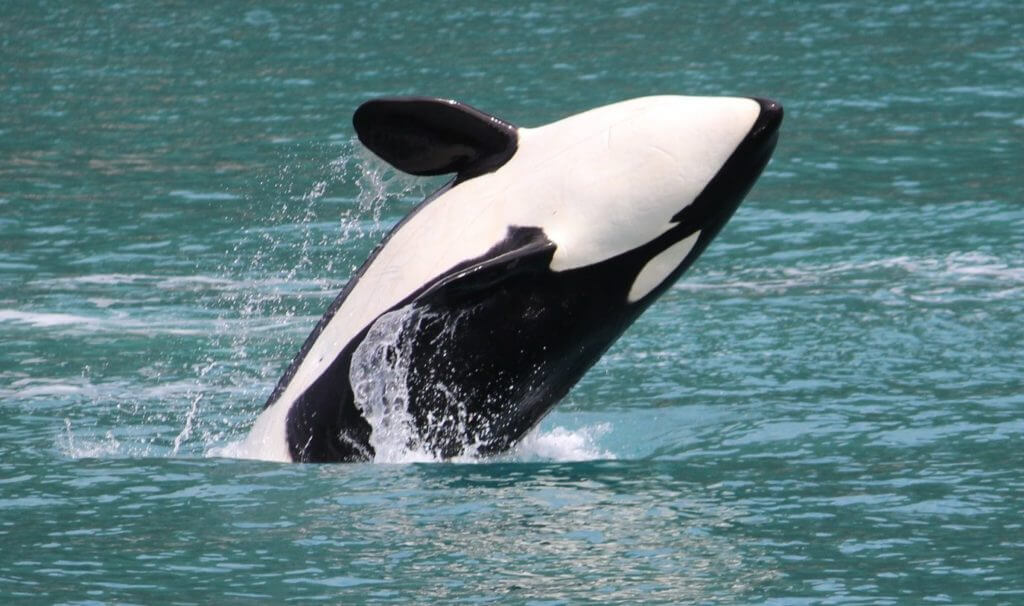Looking out over the snowcapped mountains and the silent waters of Resurrection Bay during the winter months, we can’t help but wonder what the wildlife will have in store for us in the upcoming season. After the 2017 season ended with a rare sighting of transient orcas hunting Dall’s porpoise, the anticipation for the 2018 season was at an all-time high, and it did not disappoint.
This year, with the addition of our new high-speed catamaran, the Kenai Fjords 360, we were able to take a record number of passengers into the beautiful Kenai Fjords to see the unforgettable glaciers and wildlife. Each season the wildlife is unpredictable, but over the last few years we have been observing some new trends in the behaviors of humpback and orca whales, resulting in many incredible wildlife encounters this season.

For the past several seasons we have seen the same group of one to four humpback whales lunge feeding right outside the harbor. This behavior typically starts in the middle of June and lasted for about a month in 2018. From mid-June through mid-July, the first thing that passengers got to see after leaving the harbor was this spectacular cooperative feeding behavior, making for an amazing start to each cruise. Lunge feeding occurs when a whale swims towards the surface of the water with their mouth wide open and takes a big gulp of water, filtering the small fish with their baleen plates.

Similar to lunge feeding, we also witnessed bubble-net feeding towards the end of June. This behavior occurs when a group of humpback whales dive down deep below a school of fish and blow bubbles out their blowholes while swimming in a spiral on the way back up. This pushes the school of fish to the surface, where the whales will lunge out of the water and take in large mouthfuls of food. This cooperative feeding technique is very common in Southeast Alaska and didn’t start to become a regular occurrence in Seward until 5 years ago. Since then, we can typically anticipate anywhere from one to three weeks of bubble-net feeding around the 4th of July. This year, it lasted about a week at the end of June, and took place throughout Harding Gateway at the edge of Resurrection Bay.

One trend we noticed this year was a substantial increase in black bear sightings. The best time to see bears from the boats is in May, before all of the foliage has grown back and after the snow has melted. The majority of the black bears we see are on the shores and mountainsides of Aialik and Harris Bay. This year, we saw black bears throughout the summer and even witnessed one swimming through glacier ice! Black bears feed on berries, plants, and salmon on the coast of Kenai Fjords National Park.

If you ask anyone at Major Marine Tours what the highlight of their summer was, you would get one unanimous response: orcas. All of the captains, some of which have been with Major Marine Tours for over two decades, will tell you that this was the best year for killer whales that we have ever had. In 2017 we launched a new cruise that focused on finding the orcas during peak season. The Orca Quest continued its success in 2018 with not only finding orcas, but getting some amazing encounters of superpods (when many orcas congregate in one area, making a group of 40 orcas or more), vocalization, breeding, and overall playfulness.

Peak orca season in the Kenai Fjords begins in the middle of May and ends in the middle of June. During this time the king salmon are running and several pods of resident killer whales come to join the feast. This occurred again this year, providing very exciting early season tours. What we did not expect, however, was the flurry of orca encounters that happened again at the end of August and most of September. Ordinarily, after peak orca season, we see orcas periodically throughout July and August, with a bit of an influx during the silver salmon run at the beginning of August. This year, the end of summer brought pristine sunny skies, calm seas, and orcas almost on a daily basis. We witnessed a record number of breaching resident orcas and transient killer whale predation. Transient killer whales, the species that feeds on marine mammals, had some impressive hunts this season as several tours witnessed these orcas throwing harbor seals into the air. Other pods were seen feasting on Dall’s porpoise and even a minke whale in Northwestern Fjord. With the late season orca arrivals, we ended up seeing orcas on over 60% of our Kenai Fjords National Park Cruises throughout the season. Take a look at our Instagram page to see several of the remarkable orca encounters we had this year.

With all of the excitement from the 2018 season we are already looking forward to starting back up again in March. Until then, we will enjoy the winter months and patiently wait to get back on the water and imagine what the wildlife has in store for us next year.

Signup for our newsletter to get the most recent Major Marine updates.